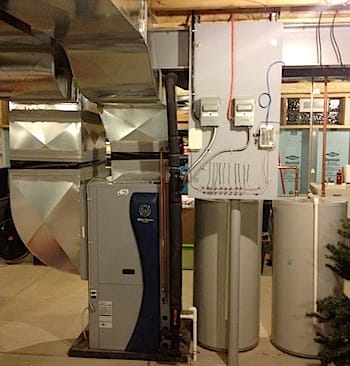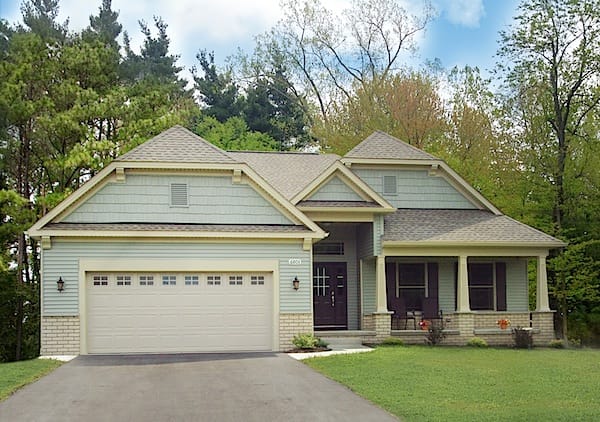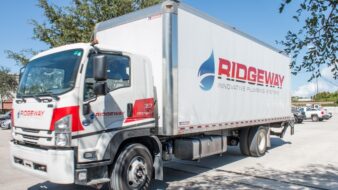Natale Builders’ newest development — Rivera Greens — in Clarence, N.Y., includes 35 single-family homes built to an energy efficiency standard unparalleled in the Buffalo/Niagara region.
In fact, Rivera Greens is the first certified National Association of Home Builders (NAHB) Green Standards Eco-Friendly Development in New York State. All home designs in the development are ENERGY STAR® rated and are expected to save homeowners 60 to 100 percent of their utility bills. What’s more, the builder is committed to offering these homes at no extra cost to its customers, demonstrating a new standard in home building and leading the way by applying cutting-edge energy-efficient technology, including geothermal heating and cooling systems.

Located in Clarence, 40-year-old Natale Builders was first introduced to geothermal by a customer who requested it in the $500,000-home he was building. As Larry LaDuca, general manager of the company, researched the technology, he realized, “In our market, geothermal is a no-brainer. It’s particularly attractive when you’re building a new home and can incorporate the cost of the system into your mortgage.”
A geothermal system takes advantage of free solar energy stored just below the surface of the earth. Using a series of pipes (an earth loop) buried in the ground and a geothermal (sometimes referred to as a ground source) heat pump, the geothermal heating and cooling system extracts heat from the earth and carries it to a building in the winter. An indoor unit compresses the heat to a higher temperature and distributes it throughout the structure. In the summer, the process reverses and the system extracts heat from the building and rejects it to the earth. In both cases, the geothermal system delivers consistent temperatures and efficiencies that exceed those of conventional HVAC systems, offering savings as high as 70 percent for heating, cooling and hot water.

In addition to consistent temperatures, a geothermal system ensures good indoor air quality (IAQ). That’s because the system doesn’t require combustion and therefore produces none of the byproducts associated with combustion, including carbon monoxide, which can be dangerous if not vented properly. And, the average geothermal system lifespan exceeds 24 years — compared to 15 years for a more traditional heating and cooling system.
Armed with this information, LaDuca set about first convincing owner Angelo Natale that geothermal was the way to go at Rivera Greens and then searching for a contractor with the capability and experience to install the systems in the development. Three to four months of searching for the right company led LaDuca to Jens Ponikau, part owner of Buffalo GeoThermal Heating.
“Jens can talk circles around anybody when it comes to geothermal,” said LaDuca. “It was his grasp of the subject and his passion for the technology that instilled confidence in us that he was the contractor who could provide us with the best installation and service.”

Ponikau is an International Ground Source Heat Pump Association certified geoexchange designer (CGD) who brought more than 20 years of experience to the Rivera Greens project. The challenge for him was two-fold: to reduce his installation costs to meet the builder’s commitment to provide energy-efficient homes at no extra cost and to provide a geothermal design that could be applied to all six model homes offered in the development.
To reduce installation costs, Ponikau ruled out a vertical loop and a traditional horizontal loop, opting instead for a stacked slinky loop field. This system uses slinky coils rather than straight pipe, which are stacked in a horizontal trench, one at a depth of eight feet and a second directly above it at five feet. This system saves space, fitting approximately 18 feet of coils in each linear foot of trench, and significantly reduces the amount of time required to complete an installation.
And according to Ponikau, the same basic design can be applied to all models, making it cost effective. “We don’t have to re-engineer or re-market everything with each house we build,” he said. “Natale sells a house, gives us the purchase order and we get to work. It’s really that simple, and by reducing our costs and adding in tax credits for the installation of a geothermal system, the homeowner ends up with a home heating and cooling system that is very close in cost to a gas-fired system and far more efficient.”
Sizing the geothermal equipment to meet the requirements of homeowners at Rivera Greens was another challenge for Ponikau. “We decided to install the WaterFurnace 3-ton 5 Series, which provides great performance and the versatility to meet everyone’s unique needs.”
Rivera Greens homeowner Duane Pusch would agree. The new fan of geothermal technology freely admits he was unfamiliar with and even a bit skeptical of geothermal before building his home. But, he read the literature provided to him, and like LaDuca, realized that geothermal technology seemed to make good sense. Eventually Pusch made the decision to install a geothermal system and became the first homeowner in the development to do so.
Pusch heated his prior home with gas, so he was well-positioned to make a comparison of that system to the new geothermal system. “First of all, the geothermal system is far more comfortable,” he said. “I don’t feel any of the hot and cold spots that were common in my former house. The geothermal system provides a much more consistent level of heating and cooling.
“It’s also cleaner,” he noted. “Seven months after the system was installed, I looked at my air filter, and it still looked clear. And you can’t mention geothermal without talking about the energy savings,” said Pusch. “My average electricity bill last July through January was $85, and that was for all the electricity in my house – lights, cooking, hot water and running the heat pump. It was great not to have a gas bill on top of that.
“Of course, it’s also better for the environment,” he added. That’s because geothermal systems do not emit any carbon dioxide, carbon monoxide or other greenhouse gasses, which are considered to be major contributors to environmental air pollution. As a result, the Department of Energy and the Environmental Protection Agency identify a geothermal system as the most environmentally friendly way to heat and cool a home.
Rivera Greens features a number of other environmentally friendly features. Homes are less than a half mile from shopping centers, recreation facilities and religious centers. A freshwater well and pond are home to natural vegetation and protected wildlife. Walking paths, composting areas and protected lands lie within 100 feet of homes. Ten acres, or 50 percent of the development, are dedicated to green space. Streetlights, the pond pump and the Rivera Greens sign are powered by a windmill. A community greenhouse is available to all residents to grow plants and vegetables. Recycling is located at the rear of the development and encouraged. Special grass in the common area has low watering needs. A public gazebo was constructed using 150-year-old wood taken from a barn that once stood on the property.
The homes, themselves, boast their own brand of environmental compatibility. Beyond the geothermal systems, the list of green features includes cradle-to-grave products like bamboo and cork flooring, low VOC paint, precast basements, LED lighting, solar panels, ENERGY STAR® rated appliances, recycled tile and low-flow plumbing.
“People are responding positively to all of these offerings. Even the geothermal system is definitely becoming more and more of a selling point, with more people asking for it,” said LaDuca. “They want to see the bills for the model we built, and when we show them an electric bill with no gas bills and lower air conditioning costs, they are impressed. Then, when you explain how to offset the electric bill with solar power, well that’s a homerun!”
The success of the geothermal installations at Rivera Greens is being repeated in other Natale homes. In fact, today, 90 percent of the builder’s clients – including homes ranging from $200,000 to $2 million — are opting for green built, geothermal supplied homes, and geothermal is rapidly becoming the standard for Natale.
According to Ponikau, the Rivera Greens model home is set between 68 and 70 degrees F, so the house is never too cold or too warm for a showing. “It’s a great demonstration of just how comfortable a geothermal heating and cooling system is,” he said. “And by combining the efficiency of the geothermal system with a solar roof, the house runs at completely net zero, sending excess power to the grid.”
To help potential customers better understand the operating cost and the performance of a geothermal system, Ponikau streams live data from a Rivera Greens home on his company’s website.
“Seeing is believing,” he said. “We’re getting positive feedback from homeowners in the development, from the people at Natale Builders and now from potential customers who can see the system perform live online. It’s hard to argue with data that regularly reinforces what we already know and the message that we want to share – that geothermal is an efficient, economical and environmentally friendly way to heat and cool a home.”




Join the conversation: